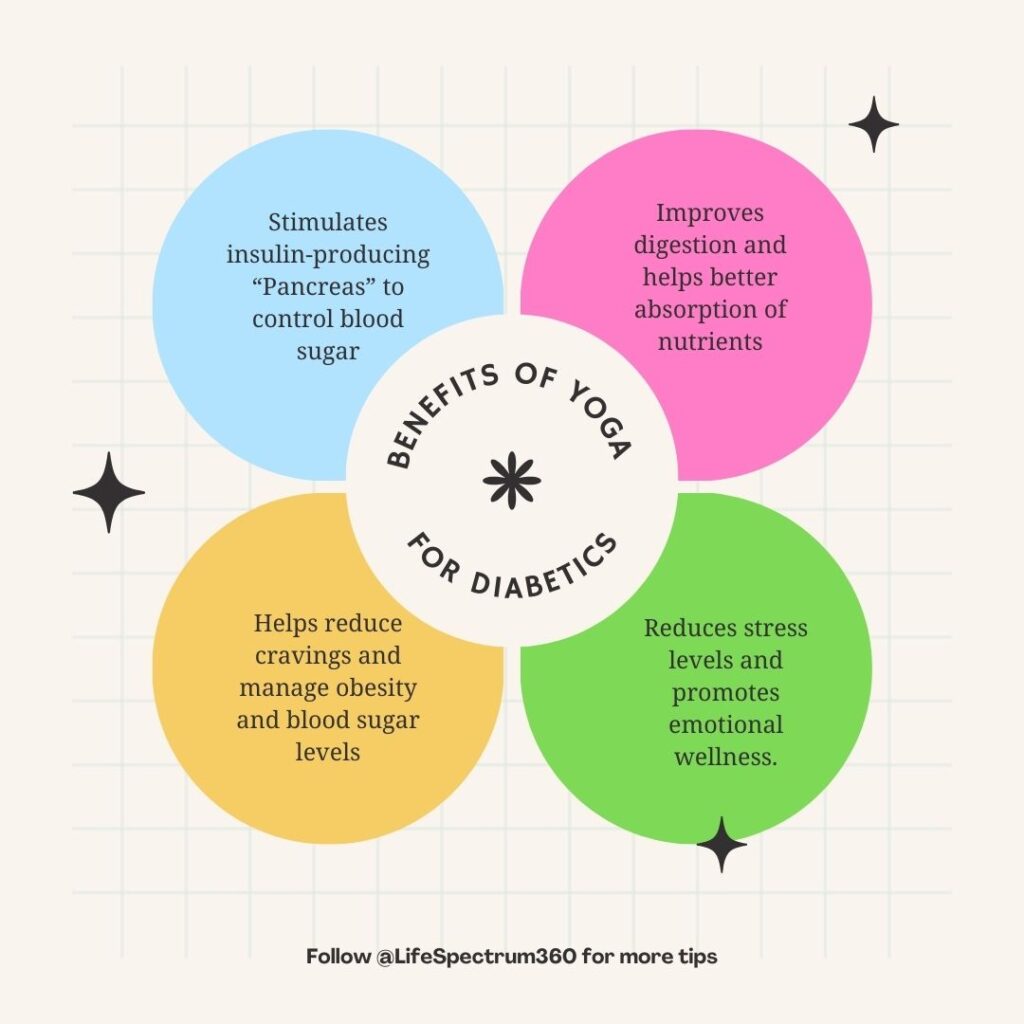
7 best yoga for diabetics: They bring down blood sugar level
Readers like you help support Lifespectrum360.com. When you purchase using links on our site, we may earn an affiliate commission. Read More.

Ashutosh Mishra
Founder & Director Explore Yoga I Online Yoga Expert l Personal Development Expert l Corporate Trainer l Experienced Yoga Coach with a demonstrated history of working in the Yoga, Wellness and health industry for more than a decade.

Dr Biswaranjan Jena
MD(Medicine) DM (Cardiology), PDCC (Diabetes) from CMC, vellore, FESC, FSCAI, Senior Interventional Cardiologist with more than 15 years of experience. He can be contacted at - Ashwini Hospital, 1, CDA Sector 7, Cuttack, Odisha- 753014
Diabetes is a chronic condition in which blood sugar levels remain at elevated levels because of two main reasons.
- The body generates insufficient insulin so that cells do not intake the glucose from the blood, resulting in a sharp increase in blood sugar levels. (Type -1 Diabetes)
- Blood has more sugar content than the body needs. (Type – 2 Diabetes.)
Diabetes has reached epidemic proportions worldwide. With an estimated 537 million adult diabetics globally, and expected to rise to 783 million by 2045, diabetes presents a significant public health challenge. This number is almost 13% of the world’s adult population, i.e. in every 8 people, 1 would be a diabetic. As each family has around 4 members, the Diabetic number translates to around 1 diabetic in every alternate family. This is alarming!!
Economic impact: A diabetic person is prone to other diseases like heart disease and stroke. Almost half of the lifetime medical costs of a person are related to diabetic complications. Complications related to diabetes can break a person financially. (Read our article on Diabetes and Heart Disease: A holistic approach to wellness.)
If your body does not produce enough insulin (i.e. Type-1 diabetes), you can look forward to getting insulin from outside. This can be through injection or an insulin pump. (Read a detailed article on How to select the best insulin pump)
But if you fall in the second category ( suffering from Type-2 diabetes), although there is no complete cure, you can control diabetes to a great extent through holistic lifestyle modifications. Due to its myriad health benefits, yoga has become a valuable adjunct therapy in diabetes management. By promoting physical activity, stress reduction, and overall well-being, yoga offers a holistic approach to diabetes care that goes beyond conventional medical treatments. In this article, we discuss the 7 asanas or poses or postures (whatever you call them) of yoga for diabetics.
7 Best yoga for diabetics
Vajrasana (Thunderbolt Pose)
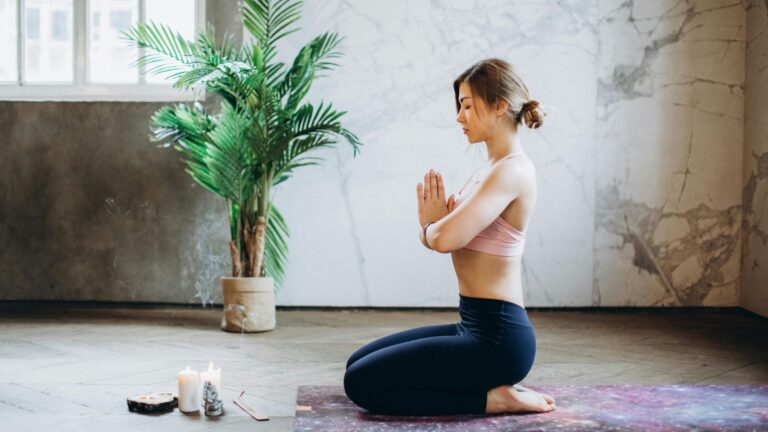
How to do Vajrasana
Start in a Kneeling Position: Begin by kneeling on the floor with your knees together and your feet slightly apart. Your big toes should be touching, and your heels should be pointing slightly outward.
Sit Back on Your Heels: Slowly lower your buttocks onto your heels. The tops of your feet should be flat on the floor, with your heels pressing against your buttocks.
Keep Your Back Straight: Ensure that your spine is erect, and your head is in line with your spine. You can place your hands on your thighs, with your palms facing down.
Relax Your Shoulders: Allow your shoulders to relax down, away from your ears. Take slow, deep breaths in a smooth and natural way. Keep your chest open and your shoulder blades gently drawn together.
Hold the Pose: Hold the Vajrasana pose for as long as comfortable, focusing on your breath and maintaining awareness of your body.
Release the Pose: To release the pose, gently lean forward onto your hands, lift your buttocks off your heels, and return to a kneeling position.
Rest: If needed, you can rest in a comfortable seated position or in Child’s Pose (Balasana) to relax your body after practicing Vajrasana.
Important tips
- Avoid practicing Vajrasana immediately after eating a heavy meal.
- If you experience discomfort or pain in your knees or ankles, you can place a cushion or folded blanket between your buttocks and heels for support.
- If you have any knee or ankle injuries, or if you’re unable to comfortably sit on your heels, it’s best to avoid or modify this pose. Do not over stress.
Paschimottanasana (Seated Forward Bend)
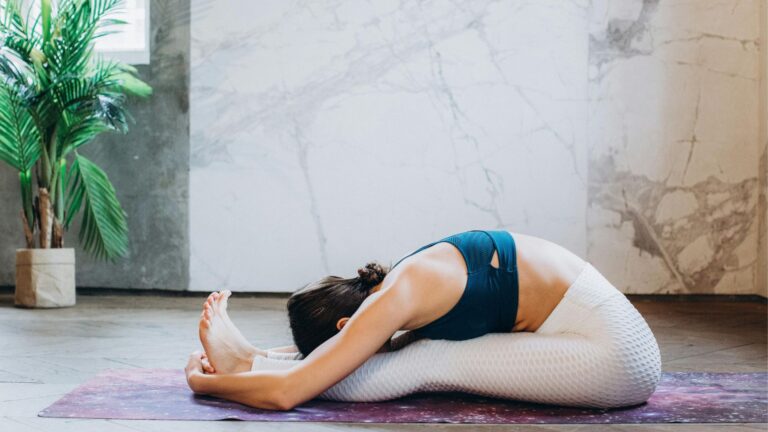
How to do Paschimottanasana
To perform Paschimottanasana, also known as Seated Forward Bend, follow these steps:
Begin in a Seated Position: Sit on the floor with your legs extended straight in front of you. Keep your spine tall and your feet flexed, toes pointing towards the ceiling.
Engage Your Abdominal Muscles: Make your abdominal muscles to be active by gently drawing your belly button towards your spine. This will help support your lower back throughout the pose.
Inhale and Lengthen Your Spine: As you inhale, elongate your spine by reaching the crown of your head towards the ceiling. Keep your shoulders relaxed and away from your ears.
Exhale and Fold Forward: On an exhale, hinge at your hips and slowly begin to fold forward from your hips, not your waist. Lead with your chest and keep your back as straight as possible as you lower your torso towards your legs.
Reach for Your Feet: Extend your arms forward or reach for your feet, ankles, or shins, depending on your flexibility. Hold onto whatever part of your legs you can comfortably reach without straining.
Relax Your Neck and Shoulders: Allow your neck to relax and your head to hang heavy. Release any tension in your shoulders and let them soften.
Breathe Deeply: Take slow, deep breaths as you hold the pose, allowing each exhale to deepen your forward fold.
Hold the Pose: Hold Paschimottanasana for 30 seconds to 1 minute, or longer if comfortable. Focus on lengthening your spine with each inhale and deepening your forward fold with each exhale.
Release the Pose: To come out of the pose, engage your core muscles and inhale as you slowly lift your torso back up to a seated position.
Rest and Repeat: Take a moment to rest in a comfortable seated position, noticing the effects of the pose on your body. You can repeat Paschimottanasana one or two more times if desired.
Important tips
- Avoid rounding your back excessively in Paschimottanasana, especially if you have lower back issues. Focus on lengthening your spine and maintaining a gentle forward fold.
- If you’re unable to reach your feet, you can use a yoga strap or towel looped around the soles of your feet to help you maintain a straight spine while folding forward.
- Be patient, practice regularly, and gradually increase your flexibility in this pose over time.
Paschimottanasana stretches the entire back side of the body, including the spine, hamstrings, and calves. It also calms the mind, relieves stress, and improves digestion.
Halasana (Plow Pose)
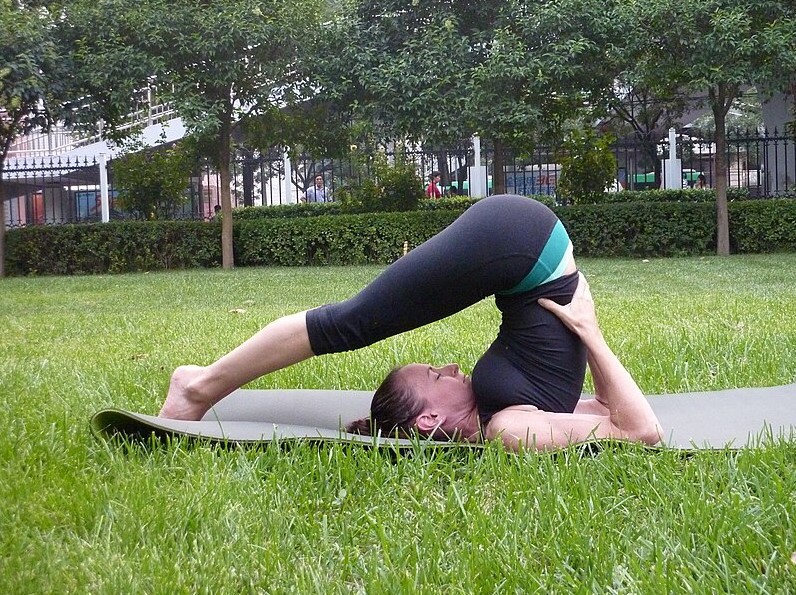
How to do Halasana
Start by lying on your back: Lie flat on your back with your arms beside your body, palms facing down. Keep your legs together and extended.
Inhale and lift your legs: Use your abdominal muscles to lift your legs off the floor, keeping them straight. Keep your feet together.
Support your lower back: Put your hands on your lower back to provide support. On the ground, keep your elbows close together.
Continue lifting your legs: Use your core strength to lift your legs up and over your head. Try to keep your legs straight as you do this.
Lower your legs behind your head: Continue to lift your legs until your toes touch the ground behind your head. Your back should be perpendicular to the ground.
Support your legs: Once your feet are on the ground, you can release your hands from your lower back and place them on the ground for support. Your arms should be straight and parallel to each other.
Hold the pose: Stay in this position for several breaths, breathing deeply and evenly.
To release: Slowly roll your spine down onto the floor, one vertebra at a time. Keep your legs straight as you do this, and use your core muscles to control the movement.
Rest: Once you are back in the starting position, take a moment to rest and relax.
Important tips
- Maintain straight legs: Aim to keep your legs straight and active during Halasana to deepen the stretch along the back of your legs and spine. Avoid locking your knees, and engage your thigh muscles to support the pose.
- Protect your neck: Be mindful of your neck alignment in Halasana. Keep your neck relaxed and avoid any excessive pressure on the cervical spine. Gently tuck your chin towards your chest to maintain a neutral neck position.
- Use props if needed: If you’re unable to reach the ground with your feet in Halasana, consider using yoga props such as blocks or bolsters to support your legs. This can help you ease into the pose and maintain proper alignment.
Ardha Matsyendrasana (Half Lord of the Fishes Pose)

How to do Ardha Matsyendrasana
Ardha Matsyendrasana, also known as Half Lord of the Fishes Pose, is a seated twist that provides a deep stretch for the spine, shoulders, and hips. Here’s how to practice it:
Start in a seated position: Begin by sitting on the floor with your legs extended in front of you.
Bend your knees: Bend your knees and place your feet flat on the floor, keeping them hip-width apart.
Position your right foot: Slide your right foot under your left leg, bringing it to the outside of your left hip. Your right knee should point forward, towards the ceiling.
Cross your left leg over your right: Cross your left leg over your right knee, placing your left foot flat on the floor outside of your right thigh. The angle of your left knee should be upward and toward the ceiling.
Ground yourself: Ground down through your sitting bones to establish a stable foundation.
Inhale and lengthen your spine: On an inhale, elongate your spine, lifting through the crown of your head.
Twist to the right: Exhale and twist your torso to the right, bringing your left hand to the outside of your right thigh or placing it on the floor next to your right hip. As you twist, maintain a straight spine.
Bring your right hand behind you: Reach your right arm behind you, placing your right hand on the floor or on your left thigh, whichever is accessible. Use your right arm as a support to deepen the twist.
Gaze over your right shoulder: Turn your head to look over your right shoulder, if comfortable, to deepen the twist.
Hold the pose: Hold Ardha Matsyendrasana for 30 seconds to 1 minute, breathing deeply and maintaining the twist.
Release the pose: To release, inhale and lengthen your spine, then exhale as you unwind from the twist. Repeat the pose on the opposite side by switching the position of your legs.
Return to a neutral position: After practicing both sides, return to a neutral seated position with your legs extended in front of you.
important tips
Avoid Collapsing the chest or rounding the back: Maintain length in your spine throughout the pose to avoid collapsing the chest or rounding the back. Keep your spine tall and elongated, drawing your shoulder blades down and back to open the chest and maintain proper alignment.
Avoid Overarching the lower back: Avoid overarching your lower back in Ardha Matsyendrasana, as this can compress the lumbar spine and lead to discomfort or injury. Engage your core muscles to support your spine and keep your pelvis in a neutral position throughout the twist.
Straining the neck: Avoid straining your neck by forcing your head to turn further than feels comfortable in Ardha Matsyendrasana. Keep your neck in a neutral position or gently turn your head in the direction of the twist without forcing the movement. Listen to your body and only turn your head as far as feels natural and comfortable.
Do not hold your breath: Avoid holding your breath while in Ardha Matsyendrasana. Instead, focus on breathing deeply and evenly throughout the pose to enhance relaxation and facilitate the release of tension. Use your breath to create space in the areas of the body being stretched and twisted.
Do not force the pose if you have injuries or discomfort: If you have any neck, back, or hip injuries, or if you experience discomfort in Ardha Matsyendrasana, it’s important to avoid forcing the pose. Pay attention to your body and adjust the stance to fit your unique requirements and physical constraints. Consult with a qualified yoga instructor or healthcare professional for guidance on appropriate modifications.
Bhujangasana (Cobra Pose)
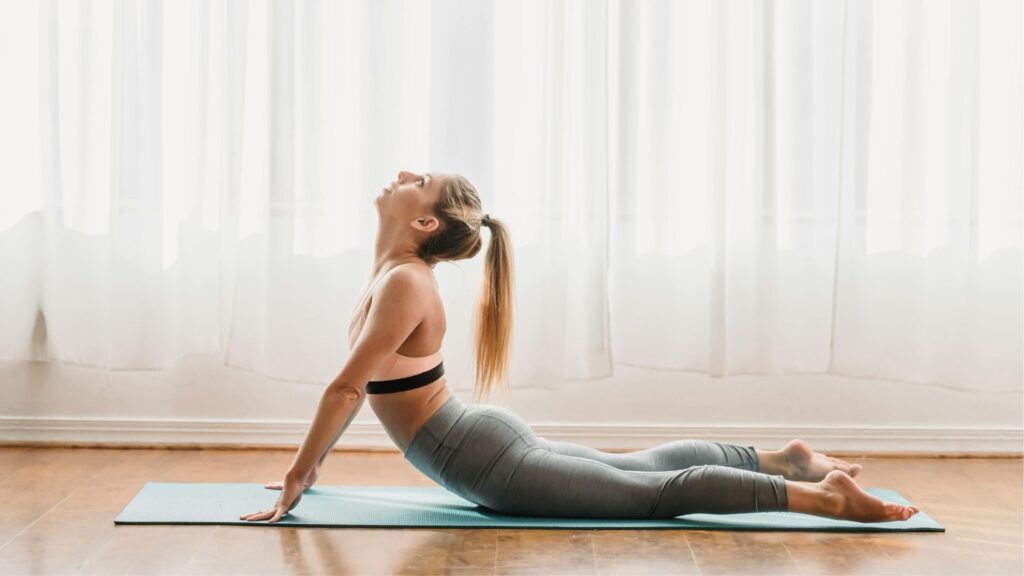
How to do bhujangasana
Bhujangasana, also known as Cobra Pose, is a rejuvenating backbend that strengthens the spine, opens the chest, and improves posture. Here’s how to do it:
Start in a prone position: Lie face down on your yoga mat with your legs extended behind you and the tops of your feet resting on the mat.
Place your hands: Position your hands underneath your shoulders, palms facing down and fingers spread wide. Your elbows should be close to your torso.
Engage your legs: Press the tops of your feet and thighs firmly into the mat to activate your leg muscles.
Inhale and lift your chest: As you inhale, slowly begin to straighten your arms and lift your chest off the mat. Keep your elbows close to your body and use the strength of your back muscles to lift.
Keep your pelvis grounded: Press the pubic bone firmly into the mat to stabilize your pelvis and protect your lower back.
Lengthen through your spine: Extend through the crown of your head as you lift your chest, creating length along your spine. Avoid collapsing into your lower back.
Draw your shoulder blades together: Roll your shoulder blades down and back, opening your chest and broadening across your collarbones.
Gaze forward or slightly upward: Keep your neck in a neutral position or gently lift your gaze upward, avoiding any strain in your neck.
Breathe deeply: Take slow, deep breaths as you hold the pose, allowing your chest to expand with each inhale.
Hold the pose: Hold Bhujangasana for 15-30 seconds, or longer if comfortable, breathing deeply and evenly.
Release the pose: Exhale as you slowly lower your chest back down to the mat, releasing any tension in your back. Lay your head down on the carpet and lean your arms next to your body.
Rest in Child’s Pose: After releasing the pose, you can rest in Child’s Pose (Balasana) to stretch and relax your back.
Bhujangasana is a gentle yet powerful pose that can help alleviate stiffness in the spine, improve digestion, and boost mood and energy levels. To reap the maximum rewards, practice it frequently.
important tips
- Avoid pressing into your hands with excessive force, instead focus on using the strength of your back muscles to lift.
- Keep your shoulders relaxed and away from your ears to prevent tension in your neck and shoulders.
- If you have any neck or back injuries, or if you’re pregnant, it’s best to avoid deep backbends like Bhujangasana or practice under the guidance of a qualified yoga instructor.
- Listen to your body and modify the pose as needed to suit your level of flexibility and comfort.
Dhanurasana (Bow Pose)

How to do dhanurasana
Dhanurasana, also known as Bow Pose, is a backbend yoga pose that resembles an archer’s bow. Here’s how to perform Dhanurasana:
Lie on your stomach: Start by lying flat on your stomach with your legs hip-width apart and your arms resting alongside your body, palms facing up.
Bend your knees: Bend your knees and bring your heels towards your buttocks, keeping them hip-width apart.
Reach back with your hands: Reach your hands back towards your ankles or feet, and grasp the outside of your ankles or feet with your hands.
Inhale and lift your chest: As you inhale, lift your chest off the ground and simultaneously kick your legs back into your hands. This action will help lift your thighs and upper body further off the ground.
Extend through your arms and legs: As you continue to lift your chest and thighs, extend through your arms and legs, pulling your feet away from your body.
Look forward: Keep your gaze forward to maintain balance and avoid straining your neck. Your head can be in a neutral position or slightly lifted.
Arch your back: Continue to lift your chest and thighs as you arch your back, creating a bow-like shape with your body. Feel the stretch across your abdomen and chest.
Hold the pose: Hold Dhanurasana for 15-30 seconds, breathing deeply and evenly. Focus on opening your heart and lifting your chest towards the sky.
Release the pose: Exhale as you gently release your ankles or feet and lower your chest and thighs back down to the ground. Rest your forehead on the mat and relax your arms alongside your body.
Repeat: Repeat the pose 2-3 times, taking breaks as needed between each repetition.
Dhanurasana stretches the entire front of your body, strengthens your back muscles, and improves spinal flexibility. It’s an invigorating pose that can help boost energy and alleviate fatigue.
important tips
- To stabilize your lower back and safeguard your spine, contract your core muscles.
- Press your pubic bone into the mat to help stabilize your pelvis.
- Remain calm and keep your shoulders away from your ears.
- If you have difficulty reaching your ankles or feet, you can use a yoga strap looped around your ankles to assist in the pose.
- Avoid straining or forcing your body into the pose. Work within your range of motion and gradually progress over time with consistent practice.
Surya Namaskar (Sun Salutation)
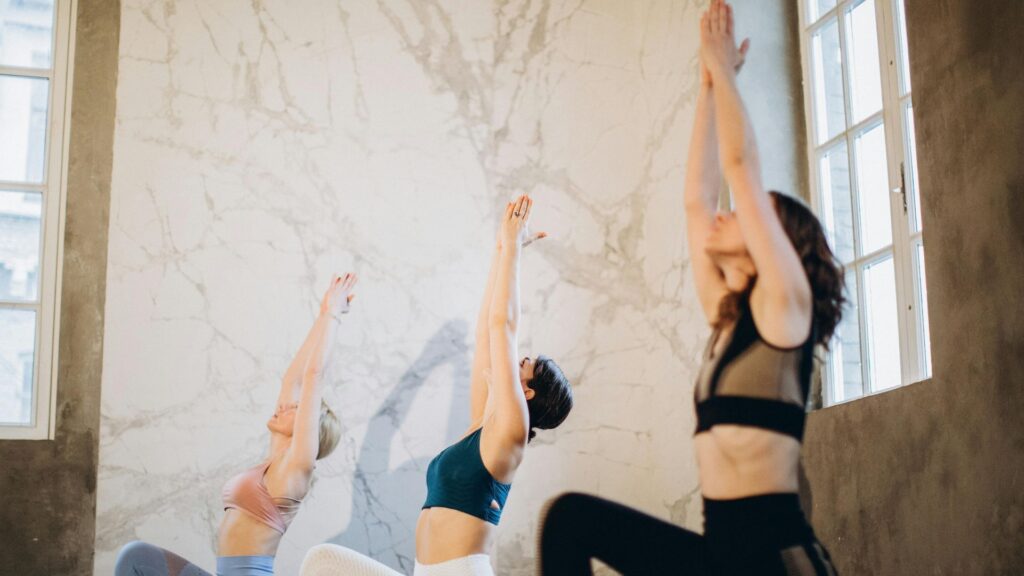
How to do surya namaskar
Surya Namaskar, also known as Sun Salutation, is a series of yoga poses performed in a flowing sequence. Here’s the detailed guide to perform Surya Namaskar:
-
Prayer Pose (Pranamasana):
- Place your feet together and place your palms together in front of your chest as you stand at the front of the mat.
- Relax your shoulders and lengthen your spine.
- Take a few deep breaths here, centering yourself.
- Place your feet together and place your palms together in front of your chest as you stand at the front of the mat.
-
Raised Arms Pose (Hastauttanasana):
- Inhale deeply as you lift your arms overhead, stretching them up towards the sky.
- Arch slightly backward, lengthening through your torso and reaching upwards.
-
Standing Forward Bend (Hasta Padasana):
- Breathe out while bending forward from the hips and maintaining a long spine.
- Bring your hands down to touch the floor beside your feet or grasp your ankles if possible.
- Keep your knees slightly bent if needed to maintain a straight back.
- Breathe out while bending forward from the hips and maintaining a long spine.
-
Equestrian Pose (Ashwa Sanchalanasana):
- Inhale and step your right leg back into a lunge, keeping your left knee bent directly over your left ankle.
- Lift your chest and gaze forward, reaching your arms up overhead if comfortable.
-
Plank Pose (Dandasana):
- Exhale and step your left leg back to come into a high plank position.
- Your body should form a straight line from your head to your heels, with your hands shoulder-width apart and fingers spread wide.
- Engage your core muscles to support your spine and keep your hips level.
-
Eight-Limbed Pose (Ashtanga Namaskara):
- As you exhale, slowly lower your knees, chest, and chin to the floor, keeping your elbows close to your body.
- Your hips and abdomen should hover slightly above the ground.
-
Upward-Facing Dog Pose (Urdhva Mukha Svanasana):
- Inhale as you slide forward and lift your chest, straightening your arms and rolling your shoulders back.
- Keep your thighs and tops of your feet pressed into the mat, lifting your hips slightly off the ground.
-
Downward-Facing Dog Pose (Adho Mukha Svanasana):
- Exhale and lift your hips up and back, coming into an inverted V-shape.
- Press your palms firmly into the mat and lengthen through your spine, reaching your heels towards the floor.
- Keep a slight bend in your knees if needed to maintain length in your spine.
-
Equestrian Pose (Ashwa Sanchalanasana):
- Inhale as you step your right foot forward between your hands, returning to the lunge position.
- Lift your chest and gaze forward, reaching your arms up overhead if comfortable.
-
Standing Forward Bend (Hasta Padasana):
- Exhale and step your left foot forward to meet your right, folding forward over your legs.
- If necessary, keep your knees slightly bent and maintain a long spine.
-
Raised Arms Pose (Hastauttanasana):
- Inhale deeply as you sweep your arms out to the sides and up overhead, returning to a standing position.
- Arch slightly backward, lengthening through your torso and reaching upwards.
-
Prayer Pose (Pranamasana):
- Exhale as you bring your palms together in front of your chest, returning to the starting position.
- Take a moment to center yourself and breathe deeply before beginning the next round.
Repeat the sequence, alternating the leading leg for the lunge (steps 4 and 9), to complete one full round of Surya Namaskar. Aim to perform 5-10 rounds, gradually increasing as you become more familiar with the sequence and your stamina improves.
conclusion
Incorporating yoga into your daily routine is a powerful tool for managing diabetes and promoting overall health and well-being. The 7 best yoga for diabetics outlined in this article offer a range of benefits, from improving blood sugar regulation to reducing stress and anxiety. By practicing yoga regularly, individuals with diabetes can experience improvements in circulation, digestion, insulin sensitivity, and mood, ultimately leading to better diabetes management and enhanced quality of life.
It’s important to remember that yoga is not a substitute for medical treatment or medication prescribed by healthcare professionals. Diabetics must consult with a qualified healthcare provider and a Yoga Instructor before starting any new exercise regimen. Professionals will offer guidance on incorporating yoga safely into the diabetes management plan and provide personalized recommendations based on individual needs and health status.
So, whether you’re new to yoga or a seasoned practitioner, consider adding these beneficial yoga poses to your routine. With consistent practice and mindful attention, you can harness the healing power of yoga to support your journey towards better health and well-being, living life to the fullest with diabetes.
“It is health that is real wealth and not pieces of gold and silver.”
– Mahatma Gandhi
If you have any feedback or suggesstions on the article “7 Best Yoga For Diabetics”, please drop at contact@lifespectrum360.com.
FAQs on 7 best yoga for diabetics
How can yoga help manage diabetes?
- These 7 Yoga for diabetics improve insulin sensitivity, reduce blood sugar levels, promote weight loss, lower stress levels, and enhance overall well-being. Regular practice of yoga poses, coupled with mindful breathing and meditation, can have significant benefits for individuals with diabetes.
Can beginners practice any of these 7 yoga for diabetics?
- Yes, beginners can practice these yoga poses, but it’s essential to start gradually and listen to your body. Begin with gentle variations of each pose and gradually increase intensity and duration as you build strength and flexibility. It’s also advisable to practice under the guidance of a qualified yoga instructor, especially if you’re new to yoga or have any pre-existing health conditions.
How often should I practice these yoga poses?
- For optimal benefits, aim to practice these yoga poses at least 3-4 times per week. Consistency is key, so try to incorporate yoga into your daily routine to experience lasting improvements in your diabetes management.
Can yoga replace medication for diabetes?
- While yoga can be a beneficial complementary therapy for diabetes management, it should not replace medication prescribed by your healthcare provider. Yoga can help improve overall health and may reduce the need for medication in some cases, but it’s essential to consult with your doctor before making any changes to your treatment plan.
Are there any precautions to consider when practicing yoga with diabetes?
- Yes, individuals with diabetes should take certain precautions when practicing yoga, such as monitoring blood sugar levels before and after yoga sessions, staying hydrated, avoiding strenuous poses that may cause dizziness or fatigue, and listening to your body’s signals. It’s also essential to inform your yoga instructor about your diabetes and any related health concerns to ensure a safe and effective practice.
How long should I hold each yoga pose?
- The duration of holding each yoga pose can vary depending on your level of experience, flexibility, and comfort level. As a general guideline, aim to hold each pose for 30 seconds to 1 minute, breathing deeply and evenly throughout. Over time, you can gradually increase the duration as you become more accustomed to the poses and experience increased flexibility and strength.